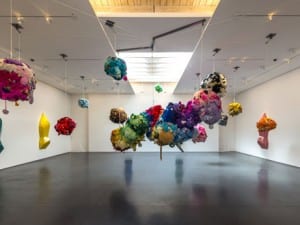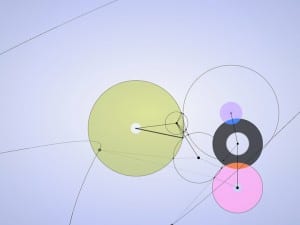A new exhibition demonstrates Merce Cunningham’s concept of movement in space and explores his relationship with art and other artists.
Collaboration is key in works of performance. It is often a space for various art forms to come together: set and costumes are designed, music is composed and performers enlisted and directed. There are many instances of great collaborations on stage between artists distinguished in their separate fields: Russian avant-garde artist Lyubov Popova (1889 – 1924) designed sets for Vsevolod Meyerhold (1874 – 1940) whilst Picasso (1881 – 1973) played a major role in designing for Diaghilev (1872 – 1929).
Dance, in particular, seems to be a place where art sits comfortably alongside performance. From Rudolf von Laban (1879 – 1958) to Shen Wei (b. 1968), dancers have sought interaction with art and artists and have drawn from the teachings of visual art to inform their choreography. In the case of acclaimed choreographer Merce Cunningham (1919 – 2009), however, the relationship between art and dance took on a different hue. Cunningham was undoubtedly influenced by the movements occuring in visual art: he was friends with Marcel Duchamp (1887 – 1968) and collaborated with Jasper Johns (b. 1930), Andy Warhol (1928 – 1987) and Robert Rauschenberg (1925 – 2008). In spite of this, Cunningham’s choreography was never directly inspired by the artistic creations of these artists because he believed in maintaining a separation between the artistic components of his performances. Dancers in the Merce Cunningham Dance Company, created in 1953 and disbanded in 2011 according to Cunningham’s wishes, never saw the set design until the day of performance.
Cunningham’s longest running collaboration was with his life partner, the avant-garde musician John Cage (1912 – 1992), and together they explored concepts of chance in the creation of art. Inspired in part by Zen philosophy and the I Ching, allowing chance to make decisions about the direction of a piece was, for Cunningham, a way of widening the possibilities of movement even further. Unrestrained by logic and reason, a piece of dance became a miracle of accidents, free and pure. One of Cunningham’s primary concerns was the movement of the body in space. He was an advocate Einstein’s theory that there are no fixed points in space, and he encouraged his company of dancers to decentralise movement on stage. He was also involved with the LifeForms program, a computer program designed to generate movement and motion-capture, this digital choreography offering Cunningham yet another means by which to discover new methods of movement for the human body.
In a new exhibition at Museum der Moderne, Salzburg, these concepts of movement are explored in a selection of photographs and video footage. Developed to complement a major John Cage exhibition taking place at the same venue, Merce Cunningham Dance Company: Photographs of a Dance Movement showcases around 200 photographs capturing the variety of Cunningham’s productions and their emphasis on chance and movement.
Many of the works on show are on loan from the German Dance Archive, but the exhibition also features works by close associates of Merce Cunningham. The curator of the exhibition, Margit Zuckriegl, speaks about the range of pieces on display: “The show has two very clearly distinguished parts: one is the “mosaic” of photographs featuring productions (coming from the Deutsches Tanzarchiv Köln), and the second part is a triptych consisting of 3 small monographic shows: James Klosty, Anna Finke and Mikhail Baryshnikov.”
Baryshnikov’s work is one of the highlights of the show. Considered one of the greatest dancers in history, his unorthodox and independent approach to dance makes him an interesting observer of Cunningham’s work. A previous exhibition at 401 Projects in New York titled Merce My Way (2008) suggests a unique and personal perspective on the choreographer. Inspired by Irving Penn, his large-format photographs are full of life, demonstrating the speed and elegance of transition. Zuckriegl expands on his work at Museum der Moderne: “His view is from the position of a dancer watching his colleagues; he focuses on the potential of depicting movement by using the effects of blur and pastel colours to show their changing coordinates in time and space.”
Offering a different but equally intimate look at the relationship between Cunningham and his company of dancers is James Klosty. Klosty is the partner of Carolyn Brown, one of the founding dancers of the Merce Cunningham Dance Company, and he joined the company from 1969 to 1972. “His photographs are personal documents of a gang of friends involved in tournée-trips, performances in cities in Europe and the US and atmospheric glimpses on the stage showing the protagonists in explicit black and white contrasts.”
The third set of works in the triptych comes from Anna Finke, a young costume designer who photographed Cunningham’s late productions at Westbeth Center for the Arts in New York City between 2007 and 2011. Zuckriegl describes her images: “She works with a determined sense of colour and isolates the dancing figures in front of a dark, unlimited space.” This isolation of the figures fits perfectly with Cunningham’s ideals about movement and the dispersal of power. In Cunningham’s pieces, each of the dancers is a soloist.
Any exhibition that aims to present the work of a choreographer, especially one as invested in ideals of movement as Cunningham was, is bound to come across challenges. One of Cunningham’s most famous quotations demonstrates the ephemeral nature of the medium perfectly: “You have to love dancing to stick to it. It gives you nothing back, no manuscripts to store away, no paintings to show on walls and maybe hang in museums, no poems to be printed and sold, nothing but that single fleeting moment when you feel alive. It is not for unsteady souls.” The impermanent and transient nature of dance as an art form means that photography and any attempt to capture a moment of dance will necessarily be lacking. The major obstacle for any presentation of this work is to overcome these limitations.
Zuckriegl accepts these difficulties: “There are different positions in ‘dance-photography’: images that give an impression of the performance, which are staged situations made in the studio for the camera, and other images that talk about situations during rehearsals and backstage.” The exhibition does not shy away from the problems of capturing dance, and instead offers an exploration of the diverse ways in which dance is portrayed through visual media.
With this in mind, the show offers a varied selection of photographic perspectives: from dancers and photographers with close personal relationships with the company to a range of performance shots that demonstrate Cunningham’s prodigious oeuvre. Zuckriegl discusses her desire to create a panoramic view on his concept of movement in space: “It is extremely important to have different ‘photographic languages’ to talk – in visual rhetoric – about Merce Cunningham in his different roles: Merce as a dancer, Merce as choreographer, as an individual, in collaboration and within the dance company that was selected and shaped by him.”
Photographs of a Dance Movement offers two exhibitions – one showcasing the work of Merce Cunningham, choreographer and dancer, and one celebrating the work of the artists and photographers who recorded his pieces. Each art form is as significant as the other and offers a perfect example of Cunningham’s own belief in the importance in making independent works of art that occupy the same space; works that stand alone, together.
Merce Cunningham Dance Company runs at Museum der Moderne, Salzburg, Austria until 11 November. For more information visit www.museumdermoderne.com and www.mercecunningham.org.
Bryony Byrne





